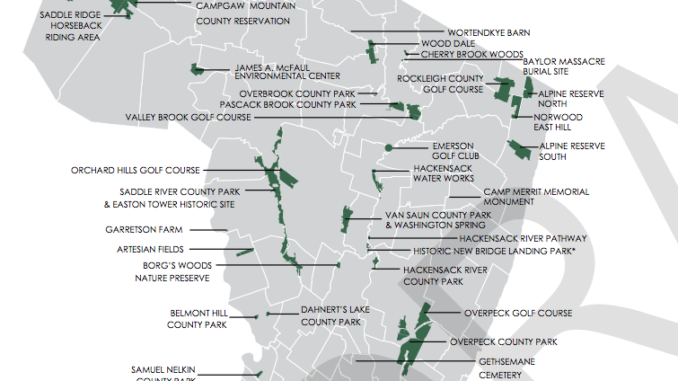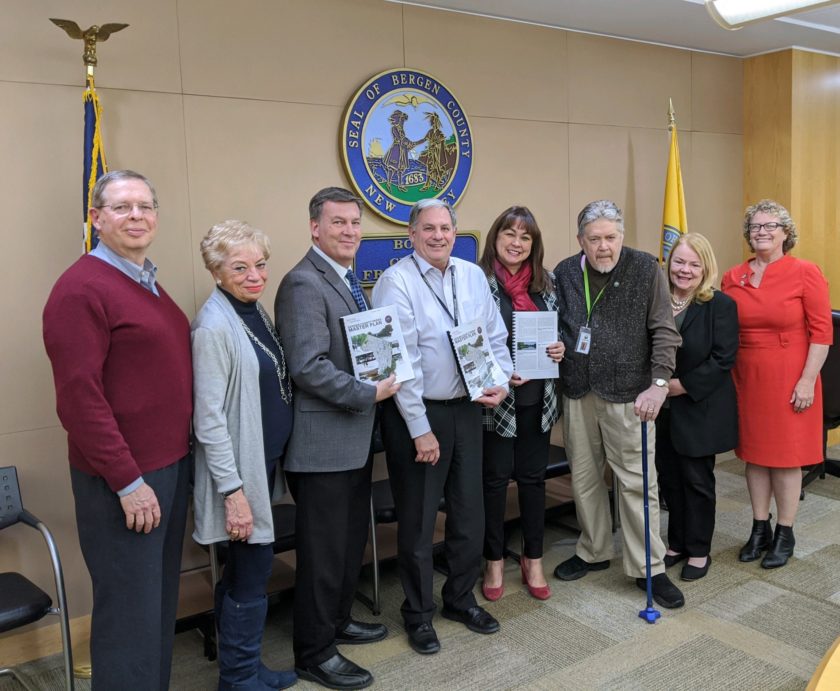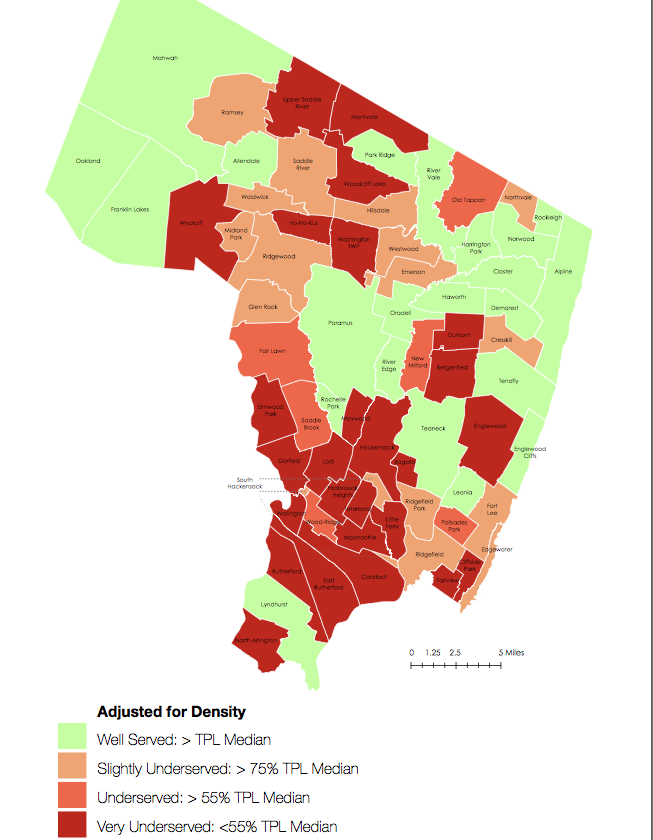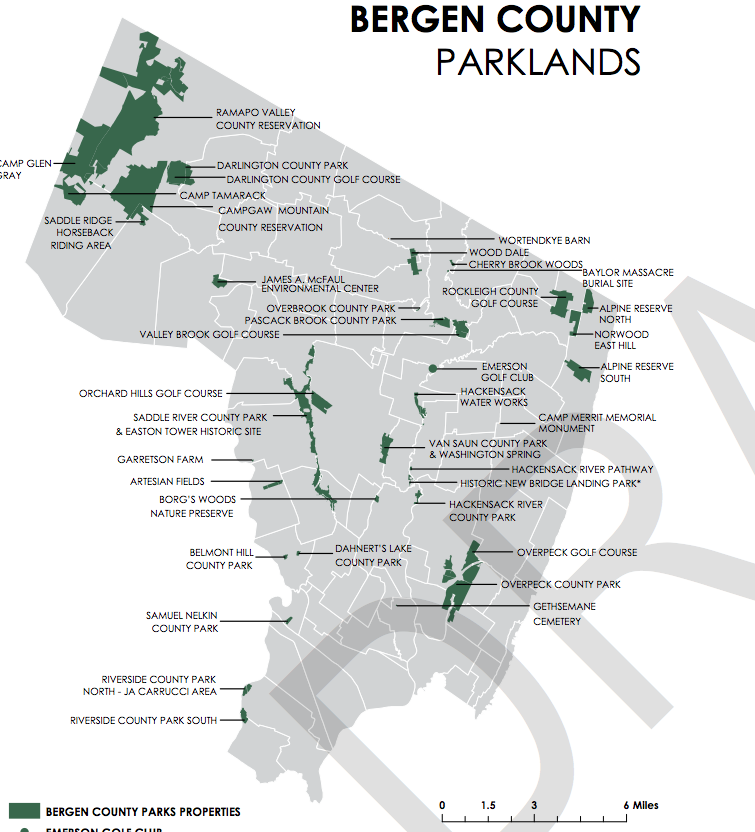
BERGEN COUNTY, N.J.—Nearly three-and-a-half years after initiating efforts for a first-ever parks master plan with much fanfare at Overpeck County Park, Bergen County Executive James Tedesco watched Dec. 18, 2019, as the county’s Board of Chosen Freeholders voted unanimously to approve a long-term strategy for county-owned parks, golf courses and open spaces.
Freeholders approved the future-oriented plan and parks officials are assessing what needs to be or should be done next.
The long-awaited 117-page planning document, called Bergen County Parks Master Plan, was begun in September 2016 by county Parks and Recreation Director James Koth, who wanted to create a long-term vision for county parks to enhance and improve facilities as well as visitors’ experience at county parks, recreation and historic facilities.
The Master Plan report cost $364,800 to produce over three-plus years of research, public outreach, and public meetings to solicit input and craft a future-focused strategy to improve and expand the range of natural, outdoor and athletic experiences possible at county parks and recreation areas.
Tedesco told Northern Valley Press that the plan’s approval means “our work is just beginning and we continually need feedback from the public about their experiences, needs and desires for their park system.”
While numerous outreach meetings were held, the Master Plan’s development was barely publicized until mid-November when advocates for Northern Valley Greenway—a proposed 7.4 mile greenway to traverse six towns on unused CSX rail line—rallied to raise awareness of the greenway effort’s absence in the master plan document.
Due to comments, conversation and lobbying, greenway advocates and leaders were able to get positively mentioned in the final document.
Moreover, their efforts generated words of praise and support from county Parks and Recreation Director James Koth and County Executive James Tedesco III.
The final Master Plan cites the greenway for “great potential” and as an example of how to connect parks and open spaces.

A ‘Master Plan’ for parks
“This vision for Bergen County parks is one in which parks are an integral part of each resident’s life, providing easy access to the open spaces of Bergen County, while preserving our natural areas and making outdoor recreation available to all,” notes an introduction to the plan.
“In this vision, Bergen County Parks compliment municipal, State, and non-profit open space, facilitating a regional network of diverse, connected recreational lands. Public open spaces are linked to each other and the surrounding communities, making a trip to the park safe, easy, and enjoyable for every resident and visitor,” says the Master Plan.
A public notice on the Master Plan’s adoption published Dec. 22, 2019, noted publication begins a 20-day “period of limitation” in which a lawsuit, action or proceeding questioning the Master Plan can be brought. Following that, the plan is officially adopted.
Thanks for participating
In an interview before the plan’s approval, Tedesco thanked residents for providing input to the master plan and said adoption of a master plan was just the beginning of parks improvements.
In one section of the report, it notes that some southern Bergen County towns have less open space per resident than towns in central and northern Bergen. Some towns are designated as “underserved” compared to a national benchmark for open space per resident, according to the report, and Tedesco wondered if residents agreed with the assessment and what might be done about it.
He recommended residents read the report, if possible, and continue to make suggestions.
“We want to make sure our residents continue to have a say and we continue to outreach to the public who ultimately use the parks, and we want residents to know that we always welcome their ideas and suggestions,” Tedesco said.
The parks plan outlines an implementation strategy, including developing individual plans with goals and objectives for each park, historic site and nature area.

Five critical elements
An overall implementation strategy recommended by Rutgers Center for Urban Environmental Sustainability, creators of the Master Plan, is structured around five critical elements.
The first element recommended is to enhance and develop the four existing regional anchor parks: Campgaw Mountain, Overpeck Park, Ramapo Valley Reservation and Van Saun Park, plus exploring options to add linear parks.
A second strategy involves developing countywide connectors and greenways to safely link every county resident to a county park.
A third element involves developing a modern digital platform to support communications with residents and facilitate daily operations of the Parks and Recreation Department.
A fourth strategy involves organizing the Parks Department to support the operations, maintenance and capital improvements required by a premier county park system.
A fifth element includes further study of “visionary, aspirational concepts” proposed in the master plan for future feasibility.
The plan recommends hiring up to 120 full-time employees, including personnel with expertise in finance, business, marketing, digital technology and environmental stewardship.
‘Predictable funding’
“The vision for the Bergen County parks system cannot become a reality, or once a reality, cannot be maintained, without predictable funding sources, a dedicated staff, and support from volunteers and the public,” states the report.
In a section titled “Test Before You Invest,” the plan recommends pilot or demonstration projects to investigate recommended ideas and to work with municipal, for-profit and not-for-profit partners to minimize costs and increase the ability to judge public acceptance and demand for new park amenities and programs.
‘Multiple funding sources’
“Implementing the proposals in this Master Plan will require time, effort, and potentially multiple funding sources. It is recommended that where appropriate, a process that utilizes demonstration and pilot projects be used to test new ideas and concepts before significant effort and funding is expended for full implementation,” notes the plan.
“It is the intention of the Bergen County Department of Parks and Recreation to further develop this implementation strategy in a detailed matrix, subsequent to the adoption of this Master Plan by the Bergen County Board of Chosen Freeholders. A separate implementation matrix that describes specific priorities, activities, and timelines would begin the long-term process of implementing the recommendations contained in this Master Plan,” concludes the Master Plan adopted Dec. 18 by freeholders.
Efforts to contact Koth for comment about new Parks Department priorities based on Master Plan recommendations were not returned by press time.
Previously, Tedesco agreed that offering new recreational opportunities and expanding parks makes sense in the future.
‘Maintain that balance’
“The plan has solidified the need for us to re-invest in and modernize our existing infrastructure which includes planning to include new recreational opportunities for people of all age groups. Striving to maintain that balance is something I have committed to,” said Tedesco in a statement.
“Whether re-investing in today or planning for tomorrow, funding is always a challenge to overcome, which is why it is more important than ever to continue to explore various means, methods, and opportunities to accomplish some of these objectives for our parks system such as business practices, public-private partnerships, shared services, philanthropic support, etc.,” added Tedesco.

